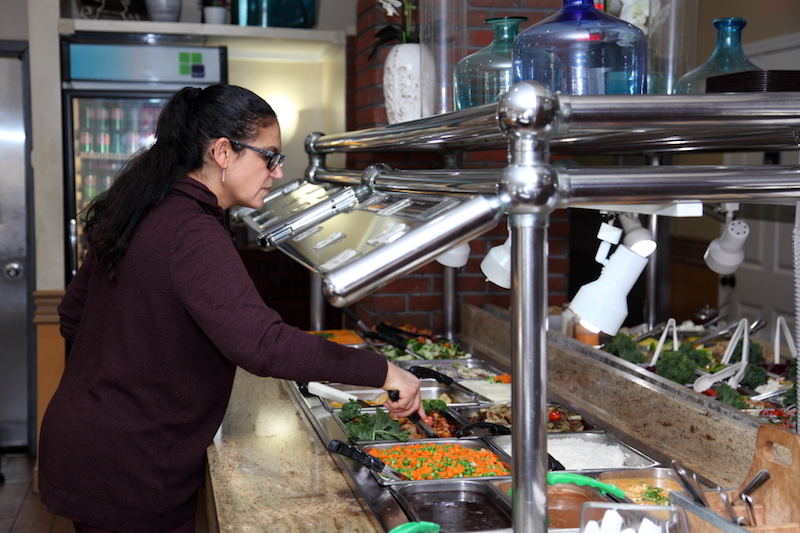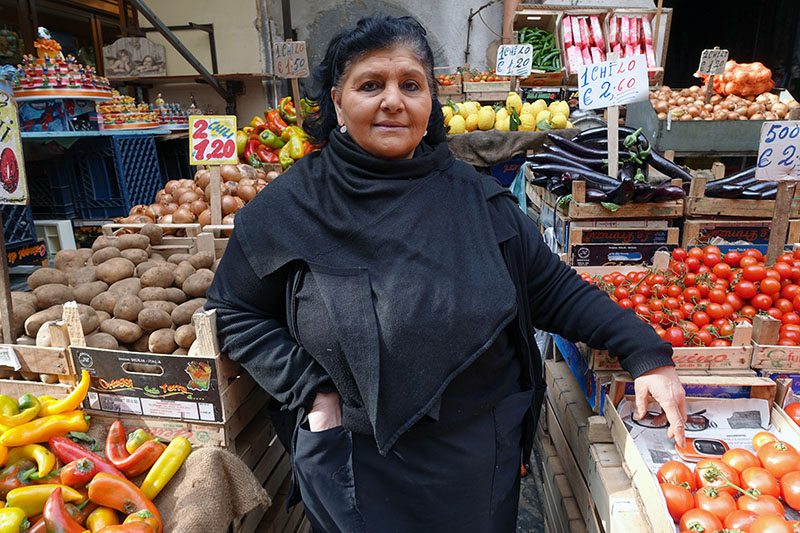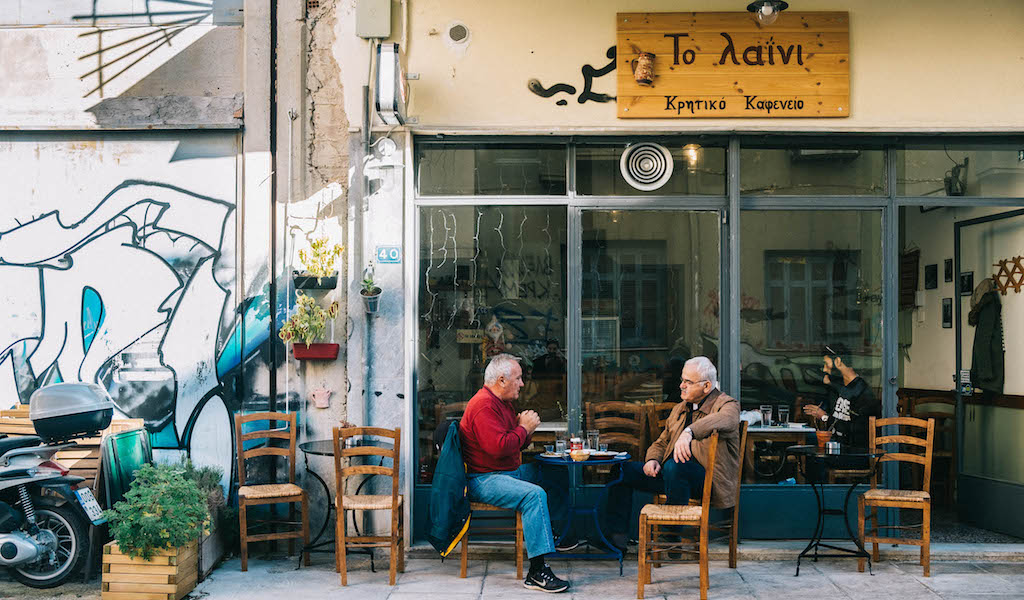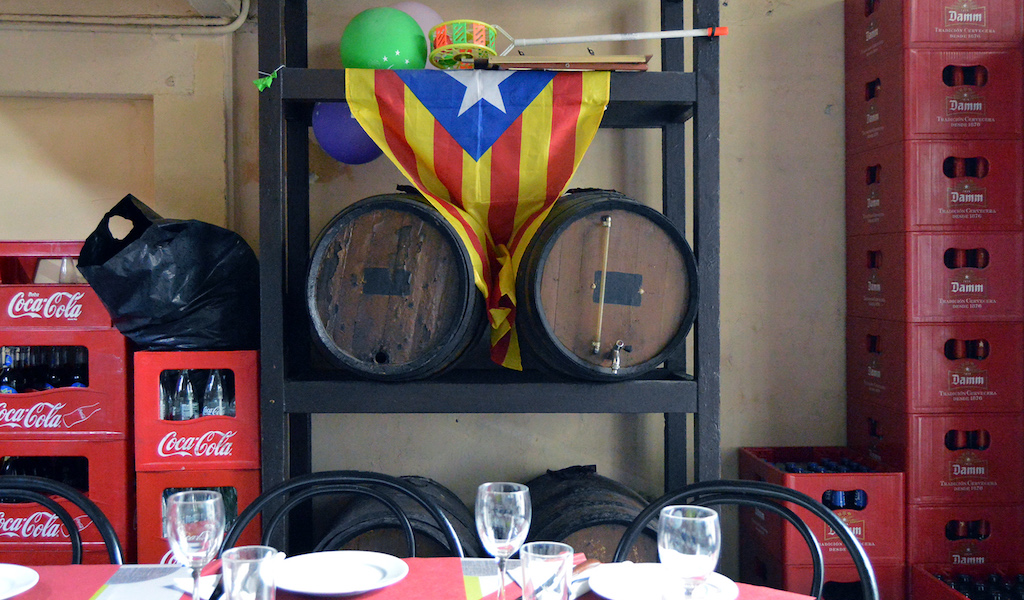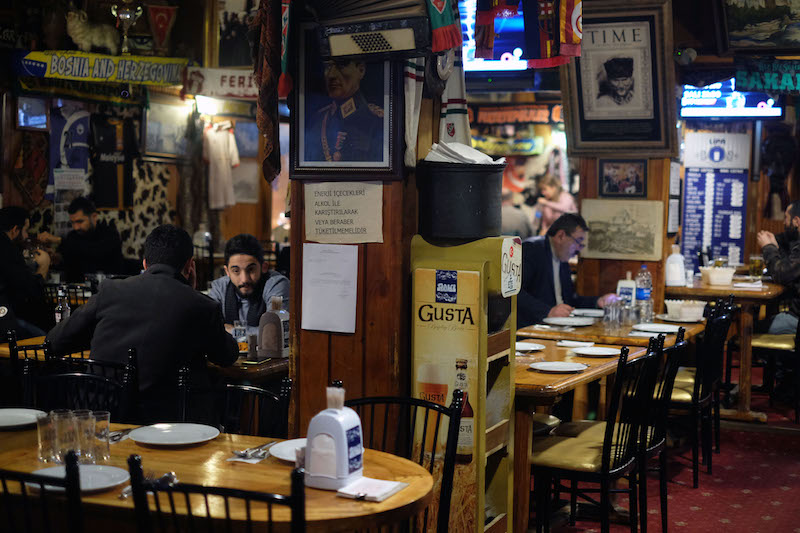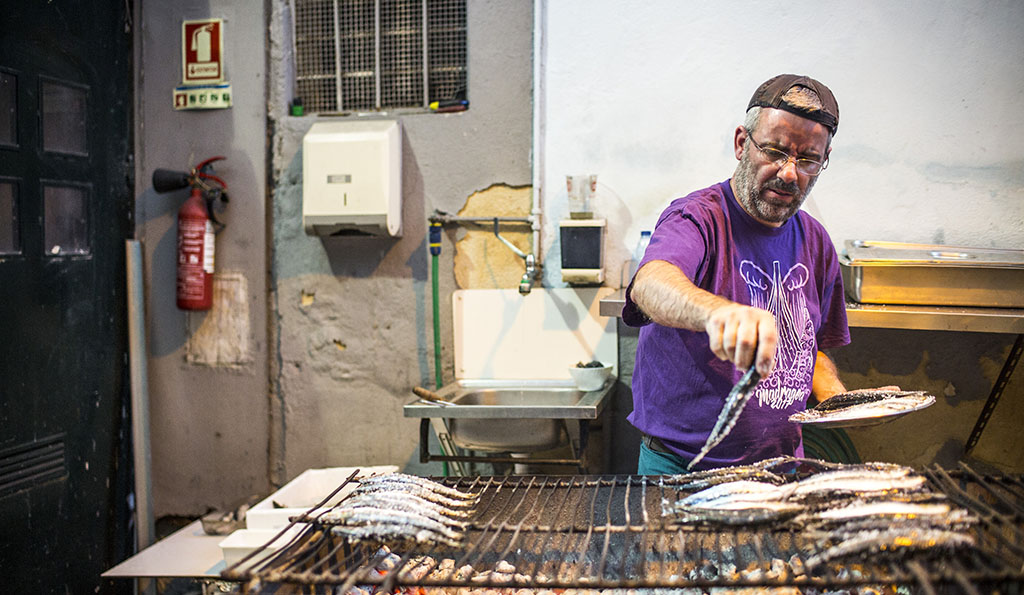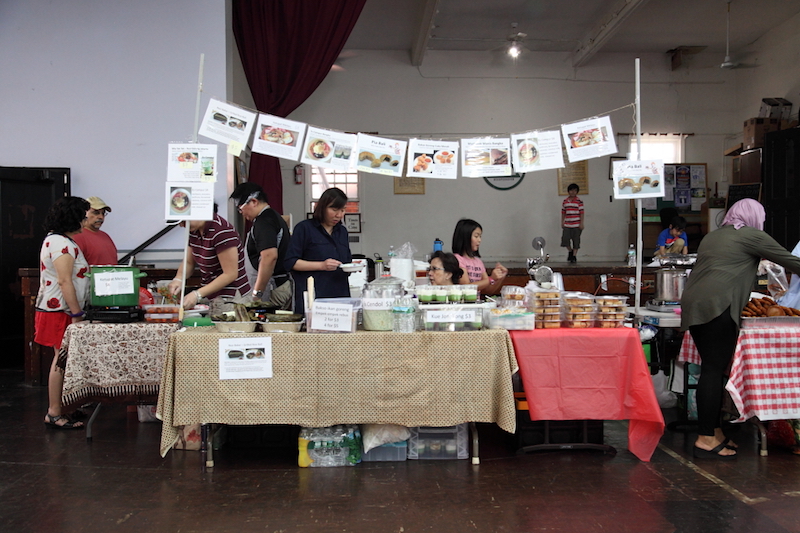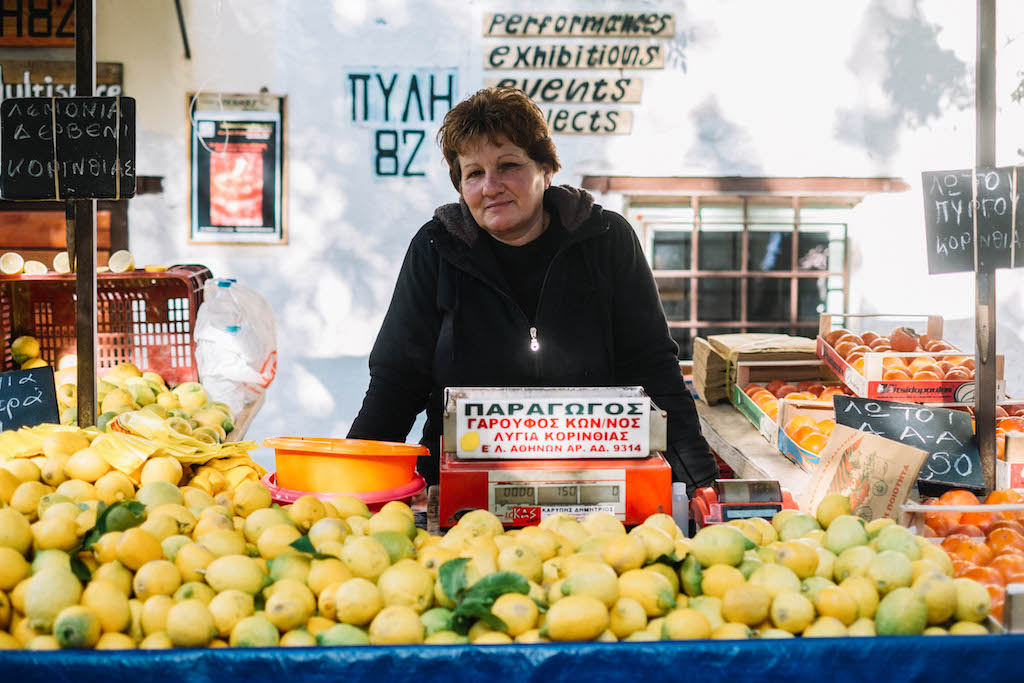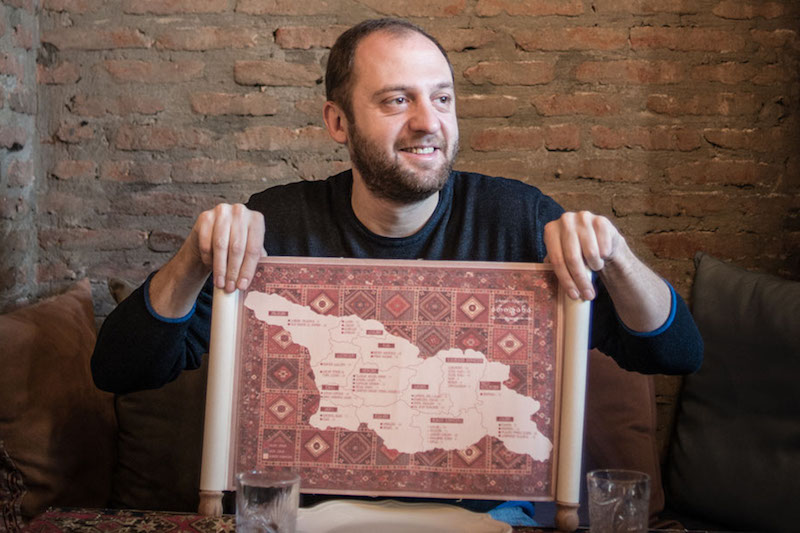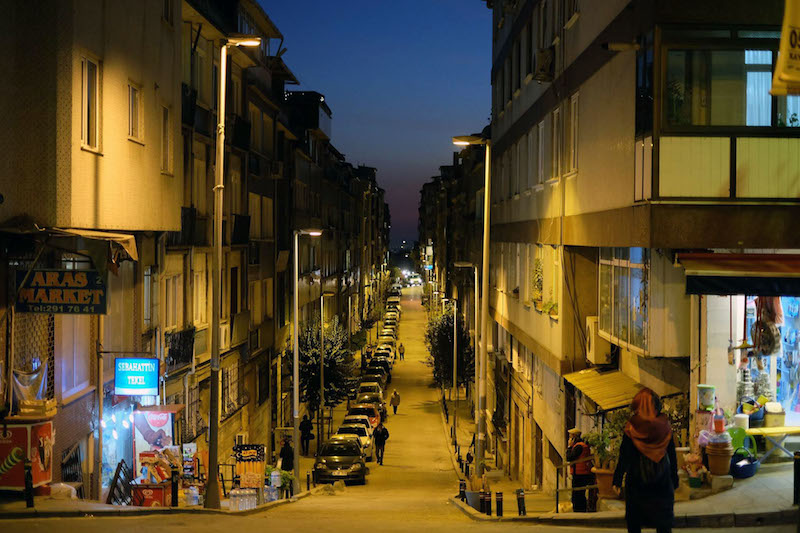We can't find the internet
Attempting to reconnect
Something went wrong!
Hang in there while we get back on track
Search results for
Naples
Friggitoria Vomero: Where Every Day Is Fry Day
There’s a saying in Naples: “Anything fried is good, even the soles of shoes.” You may laugh, but we wholeheartedly agree ¬¬– frying may have a bad rap in some parts of the world, but it can add a richness and flavor to any type of food (and, perhaps, even footwear). Think of a dull, bland zucchini or eggplant; when fried right, it becomes a pleasure. We normally get our fried fix by ordering a cuoppo, a paper cone filled with crispy morsels. This symbol of Neapolitan fried street food is our typical mid-morning snack – while going about our morning errands, we munch on the small bites of fried deliciousness that are swaddled in the plain brown paper.
Read moreQueens
Vapor Trail: Steam Table Hopping in Queens
The steam table is an often misunderstood – even maligned – concept. For those unfortunate souls who know only a lackluster corner deli, it's a repository of “food that’s been sitting around all day.” A restaurant inspector might insist on stricter criteria – something to the effect, perhaps, of maintaining already-cooked foods at safe holding temperatures by displaying them in pans above a bath of hot water. For us, particularly in the case of a praiseworthy steam table, it's "a picture menu in three dimensions.” A poetic definition, perhaps, but to us it rings true. Some displays of prepared food, we’ll agree, are not steam tables. They include the multitude of bins filled with ingredients waiting to be wedded in a Sichuan dry pot; the disposable trays, resting on wire racks above (tiny) flames, at a monthly Indonesian bazaar; or the bounty of pork and potatoes at any number of Ecuadorian street carts.
Read moreMexico City
Comixcal: Deeply Oaxacan
“There are two Oaxacan foods – what is served for tourists, and what people really eat,” says Marahí López, the chef at Comixcal, an Oaxacan restaurant in Mexico City’s Santa Maria La Ribera neighborhood. “There is a way that Oaxacan food is sold that is totally detached from the way we eat it in Oaxaca.” López knows of what she speaks, hailing from Juchitán, the culinary and cultural capital of the Isthmus of Tehuantepec, Oaxaca. She met Alexis Jiménez, who is from the Central Valleys surrounding Oaxaca City, while both were attending university in Mexico City. López and Jiménez teamed up to establish Comixcal in June 2016, after receiving degrees in Gastronomy and Anthropology, respectively.
Read moreNaples
Naples: State of the Stomach 2018
While in many parts of Europe consumer capitalism has brought an invasion of chain supermarkets and restaurants, contributing to the extinction of independent family-run grocers, Naples and the small distinct districts of its old town have magically managed to resist. The neighborhood markets retain a charm that is reminiscent of a by-gone era when Europe’s streets would smoke and hiss and the ground would be covered in cabbage crusts and fish entrails. The city’s cobbled and narrow streets revolve around civic life, which still brims with stalls selling fresh mollusks, sacks of nuts, knots of garlic and onions, rounds of cheese and hanging hams.
Read moreAthens
Well Oiled: On the Hunt for Laderá Stews
It has been said that when Greeks want a good meal, they stay at home, and that when they go out, having fun is the object, the food a secondary concern. But that was in the past. As diners have become more sophisticated and demanding, restaurants’ and tavernas’ standards have been rising and a mediocre meal is hard to find. But the craving for home cooking, for those laborious, slow-simmered soups, stews, and casseroles that mothers and grandmothers used to devote their days to creating still persists. And the old-fashioned mageirio or mageriko is an institution that satisfies this urge.
Read moreBarcelona
L’Artesana: Workers’ Delight
Years ago, when it was a booming industrial center, Poblenou saw thousands of workers stream in every day to toil away at one of several factories in the neighborhood. Hearty fare was required to keep them going – sure, taste mattered, but sustenance was the most pressing concern. Poblenou may no longer be filled with factories, but there are still plenty of people who spend their weekdays in the area, working at one of the many start-ups, tech companies or communications firms that have set up shop in their place. When it comes to lunch, these 21st-century workers want the same thing that those who came before them did: lunches that fill their stomachs and satisfy their taste buds without leaving a big hole in their pockets.
Read moreAthens
Athens: State of the Stomach
When childhood friends Yioula Svyrinaki and Michalis Psomadakis were planning last year to open up To Laini, a spot that would serve the kind of traditional food and drink found on their home island of Crete, it wasn’t very hard for them to decide on where to locate their new venture: the Keramikos neighborhood. The two budding restaurateurs were already living in the area, but there was much more that made Keramikos an ideal choice for opening up their ten-table kafeneio, which on Crete refers to a no frills café that also serves food. Located just a ten-minute walk from Athens’ buzzing historic center, the laid back Keramikos neighborhood seems to live in a magical world of its own, a place where old and new, Greece’s storied past and often turbulent present, tradition and forward-looking creativity, all coexist happily together.
Read moreBarcelona
Pour Us Another Vermut
The barman at La Bodega d’en Rafel always has a bottle of vermut and a glass at the ready. This spot also offers good cava, local wine, a well poured beer and traditional tapas, but we keep coming back because the people who work here make you feel that you belong – that there will be always a place for you at the bar.
Read moreShanghai
Auspicious Eating: Ringing in the Year of the Dog
There’s a joy in staying in China’s big cities over the upcoming Lunar New Year (春节, chūnjié). As people start the “great migration” back to their ancestral hometowns to enjoy the annual reunion dinner (团圆饭, tuányuánfàn, or 年夜饭, nián yè fàn) with their family, Shanghai becomes a ghost town. Nearly every shop and restaurant closes up for at least a week (and sometimes more like three), as employees travel back to inland provinces like Anhui and Henan for a well-earned break and the chance to eat traditional, home-cooked meals with relatives. So long as you have a well-stocked fridge, the New Year is a peaceful time to explore the empty streets.
Read moreTokyo
Hinata: A Cut(let) Above
Arriving at Hinata one recent winter afternoon, we luckily found most of the restaurant’s 14 counter seats empty. Hinata serves just one thing: tonkatsu, breaded and fried pork cutlets traditionally served with cabbage and rice. The space is simple but snazzy, all brick-shaped white tiles and pale wood. The menu hangs from wooden slats on the wall, and on this day sported a handwritten addendum saying that our usual order, the standard roast cutlet priced at ¥1,300, was out for the day. The lunch rush must have been a busy one. We decided to splurge on the shop specialty, tonkatsu made with a fatty top rib cut for ¥2,500.
Read moreShanghai
Lunar New Year Preparations in Shanghai
As Shanghai prepares to welcome the Year of the Dog, preserved poultry, fish and, as pictured here, the conger pike, a species of eel, can be spotted hanging in quiet laneways and bustling markets, ready to be purchased for traditional holiday dishes. The Lunar New Year begins on Friday, February 16, this year.
Read moreNaples
Carnival of Sweets: Sanguinaccio, Chiacchiere and Savoiardi
Sweets can stir up feelings and evoke memories of particular times of the year in a way that other foods can’t. This is particularly true in Naples, where there is a dessert for every holiday: struffoli (small fried dough balls doused in honey) and cassata (sponge cake with ricotta and candied fruit) call to mind lively and colorful Christmas celebrations, while the pastiera (a cake filled with ricotta cheese, eggs and custard) reminds us of the exuberance of Easter. While those sweets are certainly indulgent, they don’t hold a candle to chiacchiere (a sweet crispy pastry sprinkled with powdered sugar) and sanguinaccio (black chocolate pudding), which immediately bring to mind the most eccentric and unruly party of the year: Carnival.
Read moreLisbon
Post-Colonial Lisbon: Brazil Edition
Lisbon’s communities from Portugal’s former colonies provide the strongest link to the country’s past, when it was the hub of a trading empire that connected Macau in the east to Rio de Janeiro in the west. Though integral elements of Lisbon life, these communities can sometimes be an invisible presence in their adopted land, pushed out to the periphery of the city. With our “Postcolonial Lisbon” series, CB hopes to bring these communities back into the center, looking at their cuisine, history and cultural life. In this fourth installment of the series, we look at Lisbon’s Brazilian community.
Read moreLisbon
Brazil in Lisbon: Taste
Brasuca owes its existence to Mr. Oliveira da Luz, known to locals as Juca, a trade unionist who escaped from political pressures in his homeland in 1976 to settle down in the Portuguese capital. Two years later he opened this restaurant in Bairro Alto. It wasn’t the first kitchen serving Brazilian dishes in the district, as a few other tascas – particularly those with Portuguese owners who had connections to Brazil – had incorporated some Brazilian staples in their menus, particularly the feijoada, a dense meat and black bean stew, but it was the first Brazilian restaurant opened in Lisbon by a Brazilian.
Read moreLisbon
Brazil in Lisbon: Go Deep
Among the many bars of raucous Bairro Alto, Casa do Brasil is a steadfast nighttime institution for Lisbon’s Brazilian community, hosting concerts and cultural events in a non-profit capacity. This two-floor venue is the place to chat, drink, eat and dance to a myriad popular rhythms from the homeland, all performed live: the festive accordion-drone of forró, the fast, happy chorinho or 1960s bossanova, as well as samba, rock and maracatu. The grungy ground floor, which mainly functions as a bar and dance floor, also hosts poetry sessions, film screenings and gastronomic events. Usually held on Mondays, their dinners provide the ideal space for getting to know the regional specificities of Brazilian food – its 26 states occupy more than half the South American continent, meaning it will take more than a couple of visits to get a full sense of the national palate.
Read moreWorldwide
Brazil in Lisbon: History
Despite Brazil being the largest of Portugal’s former colonies, the presence of its people in Lisbon has only been felt recently. During the 1950s and 60s, Brazilians in Portugal were limited to small groups of students, a few migrant adventurers and those Portuguese descendants born in Brazil who decided to return to the motherland. However, since the 90s, a more regular coming-and-going has been taking place between Brazil and Portugal. This pendulum-like swing of migration is a consequence of their respective political and economic crises and moments of growth. At the beginning of that decade, many Brazilians moved to Lisbon in the wake of the difficult inflationary crisis that was affecting South America’s biggest nation.
Read moreRio
Põe na Quentinha: The Edible Samba Parade
When it first began five years ago, Põe na Quentinha was an informal get-together for people who were equally passionate about food, beer and samba; they spent the day eating, drinking and dancing in preparation for Carnival. Fast-forward to 2017, when what had now developed into a proper street parade drew in over 5,000 people over three different days during the Carnival Season. This year, the food-focused event, the only one of its kind in Rio, is even larger, hosting a full month-long schedule of parades that started in mid-January.
Read moreTbilisi
Something Brewing: Georgia’s Tea Renaissance
“Tea,” our friend Lasha indicated with a head nod, driving past fields with rows and rows of overgrown, chest-high, bushes of green leaves. It was 2002 and we were zipping along a skinny road littered with potholes on the outskirts of Zugdidi in west Georgia, but we could have also been in Guria or Adjara or even Imereti; regions with tea fields that have also become agrarian relics. Later we visited the last operating tea factory in town, a Soviet era rust bucket of a building that Lasha said churned out leaf dust that was sold to Lipton. Such was the fate of an industry that had once provided the USSR with 95 percent of its tea. However, after decades of inaction, Georgian tea production is slowly making a comeback.
Read moreBarcelona
Barcelona: State of the Stomach
In 1977, just two years after the death of Franco, the great Catalan gourmet Manuel Vázquez Montalbán published a book titled L’art de manjar en Catalunya (The Art of Eating in Catalonia). The book, as well as the prologue written by Montalbán’s mentor Néstor Luján, rang the alarm bells, claiming that authentic Catalan cuisine was in grave danger and on the brink of disappearance. As Montalbán saw it, the unique Catalan culinary identity has been reduced to a few ubiquitous dishes: pan a la Catalan (bread with tomato pulp and ham) and rabbit with aioli. This demise was due, in his opinion, to the frenzied pace of modern life, the lack of high-quality ingredients, the ignorance of both restaurateurs and tourists regarding what good cuisine, not to mention true Catalan cooking, looks and tastes like and, of course, the Franco regime’s efforts at suppressing regional identities.
Read moreMexico City
Birria El Güero: Landmark Soup
Colonia Santa Maria La Ribera, one of our favorite dining neighborhoods in Mexico City, is home to the historic kiosco morisco. Built in 1884, the Moorish open-air pavilion represented Mexico at the St. Louis World’s Fair in 1902 and has been in its current location since 1910. Just a few steps west of it sits a nondescript hole in the wall, which figures as prominently as the kiosk in our mental map of the neighborhood. Owner David García Maldonado offers just a few items on the menu, two of which are outstanding: pozole, a broth made from pork and maíz cacahuazintle, or hominy, and goat birria, a typical soup from the state of Jalisco.
Read moreLisbon
Tasca Tables: The Spectacular Imperial de Campo de Ourique
To describe something that is better than good, Portuguese speakers sometimes use the word espectáculo (show, spectacle) as an adjective. João Gomes, the owner of Imperial de Campo de Ourique, does it every five minutes. He practically trademarked the phrase “É um espectáculo” (It’s a show/spectacle), to the point that he has it embroidered on his apron. His wife Adelaide’s reads “A chef do espectáculo” (The show’s chef) – she’s the cook and a very good one indeed. Nuno, their son, doesn’t have an embroidered apron but he is also part of the show, waiting tables and managing orders effortlessly. Imperial used to be one of Campo de Ourique’s many outstanding tascas. Now it is probably the last one standing.
Read moreBarcelona
Espai Mescladís: Barcelona, Open City
The entryway of Espai Mescladís is jam-packed with people: neighbors, workers and visitors who come and go all day long, and waiters walking from the kitchen to the tables on the terrace. But there are also dozens of people staring out from black and white photos that cover the restaurant’s walls; some are alone, others in couples, families or groups, smiling and laughing. All the people pictured at one point emigrated to Barcelona, and whether they’re still living in the city or have moved elsewhere, their stories are always present at Espai Mescladís. The photos, taken by the photographer Joan Tomás, were originally part of an exhibition organized by the Mescladís Foundation, a multifaceted initiative that provides tangible and sustainable economic programs, particularly in the form of job training, for migrants and refugees in the city.
Read moreTokyo
Gentrification Busters: Tokyo’s Neighborhood Institutions
The city of Tokyo has over 1,000 train stations, which translates to just about that many neighborhoods. In recent years many of these communities have succumbed to top-down corporate “urban renewal,” losing the small shops and restaurants that created distinctive local flavors. With an average shelf life of 30 years for buildings, most Tokyo real estate is rebuilt as opposed to being renovated for further use. Bottom up gentrification and the repurposing or renewal of buildings is rare. Change has always been an integral part of Tokyo life, but as we begin the new year, we thought it was worthwhile to honor some of the old institutions of Tokyo and enjoy them anew.
Read moreIstanbul
Istanbul: State of the Stomach 2018
Groaning sounds emanated from the other end of the line when we told a friend the location of our dining plans for the night. The spot, a rowdy, charming dive specializing in Bosnian-style mezes and grilled meats, was in Pendik, a district of Istanbul well over 20 kilometers outside the center, on the outskirts of the Anatolian side. Our friends’ reluctance to join was a normal response in a city with terrible traffic and nightmarish commutes. Who would want to spend their free time on a three-hour roundtrip journey to eat out when there are plenty of excellent options just a stone’s throw away?
Read moreNaples
Cibi Cotti Nonna Anna: The French Connection
Neapolitan cuisine is an impure thing, the result of culinary influences from every part of the old continent. One of the most famous dishes this cross-pollination has produced is the Neapolitan potato gattò, a potato tortino rustico (a tall, square cake) with layers made of mozzarella, scamorza, ham, salami and more. A baroque dish, this gattò transforms the simple potato into a true miracle of gastronomy. The word “gattò” (not to be confused with “gatto” without the accent, which means “cat” in Italian) is the Neapolitanization of the French “gateaux” (cakes). But the Neapolitan potato gattò recalls the French gateaux only in form – taste-wise, it’s very far from a sweet French cake.
Read moreLisbon
Mezze: Rebuilding, with Food
In a market as diverse as Lisbon’s Mercado de Arroios, where people from all over the world shop, Mezze doesn’t seem out of the ordinary. But the small restaurant deserves a closer look: it’s not only one of Lisbon’s few Middle Eastern restaurants, but, more importantly, its staff is almost entirely made up of recently arrived Syrian refugees. For them Mezze represents both a link back to the country they left behind and a crucial aid for putting down roots in their new home. The idea behind Mezze is one that’s being tried out in other countries. Refugees, particularly those fleeing the war in Syria, are given the chance to earn a living and get established by sharing their culinary heritage, either by opening or working at a restaurant or catering business.
Read moreNaples
Hanging Piennolo Tomatoes in Naples
Pummarola ro piennolo (hanging tomatoes) are an essential ingredient in many Neapolitan dishes. These cherry tomatoes are harvested in the summer and then hang in ventilated cellars until Christmas time; their flavor becomes extremely concentrated in the intervening months.
Read moreRio
Beans & Beats: Pre-Gaming Carnival 2018
There’s one thing about Rio’s gastronomy that just about everyone can agree on: feijoada, the glorious black bean and pork stew served with cabbage, toasted manioc flour, rice and oranges, can (and should be) eaten all year long. But during the Carnival season (a non-specified period that begins in early January and extends until one week after the Carnival holidays), the Brazilian national dish becomes the official meal of all parties and events. From Friday to Sunday, feijoada is everywhere – at samba schools, bars, restaurants, fancy hotels, and even on the streets – and almost always accompanied by samba. This year is no different. The feijoada season has already begun, and the agenda is packed until Carnival, which in 2018 runs from February 10-14.
Read moreAthens
Tsiknaboom: Comically Charred
Walking down Pallados Street, located a few steps away from the Athens Central Food Market, is like a treasure hunt, one where the riches are the old-time kitchenware stores where past generations of Athenians used to shop for their cutlery and crystal, be it glasses, vases or chandeliers. As the years went by, the shops began adding more variety to their stock, mostly kitchen equipment and home goods. But as they grew bloated with objects charming and tacky, delicate and bulky, useful and meaningless, these shops also began to dwindle in number. Few survive among the bars and eateries that now line the street. We first stumbled upon tiny Tsiknaboom while on the hunt for these bastions of old Athens.
Read moreLisbon
Lisbon: State of the Stomach 2018
Editor’s note: Traditionally we have published State of the Stomach pieces when beginning coverage of a new city, to provide an introduction to its food culture and how it shapes daily life. But as we dive deeper into the cities we work in, we’re taking stock of what’s changed, particularly as internal and external factors reshape both the culinary and urban landscape. So we thought it was worthwhile to, over the coming weeks, reexamine how some of these cities are eating, which will inform our coverage in the new year. Next up is our look at Lisbon. Back in June, historic Lisbon neighborhoods like Alfama dressed up for the Santo António festival, just as they do every year. It’s a defining moment for the Portuguese capital – one where food, music, local customs, dance and religion all come together for a few joyous days.
Read moreRio
Mania de Boteco: A Bar in the Sky
It’s not easy to get to Mania de Boteco. You have to go up, up, up, first by car (or, for something more thrilling, on the back of a motorcycle taxi) and then by foot, cutting across alleys and climbing narrow stairwells. But this spot is worth all the effort. Tiny and humble, Mania de Boteco has an almost improvised feel to it, teetering at the top of Vidigal, one of Rio’s most scenic favelas. The first thing noticed here is the astonishing view of the ocean and Leblon and Ipanema beaches down below. But Mania de Boteco is more than just a scenic spot: it also happens to be a top-notch botequim serving wonderful food and amazingly good drinks.
Read moreQueens
Bazaar Foods: Indonesia’s Culinary Riches, Packed into One Parish Hall
For years we’ve looked into every Indonesian nook and cranny in New York, yet we always discover something new at the monthly Indonesian bazaar at the St. James Episcopal Church. We’re not surprised. Indonesia, the fourth-most-populous country in the world, comprises some 17,000 islands that stretch over a vast archipelago of diverse culinary habitats. We’ve tasted dozens of dishes and witnessed dozens more, but there must be so many soups, and stews, and fritters, and fishcakes that we have yet to set our eyes on – not to mention desserts that can be as bright as any jungle butterfly.
Read moreIstanbul
Hot Ticket to Hatay: Q&A with Author Robyn Eckhardt
In the years of research for their new cookbook, Istanbul & Beyond, author Robyn Eckhardt and photographer David Hagerman became well acquainted with Anatolia and the distinct cultural identities, landscapes and, of course, cuisines that can be found on this vast plateau. So we are pleased to be working with Robyn and Dave on the first unique culinary adventure in a series inspired by Istanbul & Beyond that will lead us across Turkey’s diverse regions, bite by bite. This seven-day culinary experience (with an optional two-day photography workshop led by Dave), scheduled for May 2018, will be split between Istanbul and the Hatay region, an area that plays an important role in Robyn and Dave’s book and in the cuisine of Turkey.
Read moreAthens
Athiri: Rare Elements
On a busy thoroughfare in Keramikos near the bustling neighborhood of Gazi, it’s easy to miss Athiri – but we urge you to keep an eye out for this culinary gem. When we last visited the restaurant, the polite waiters welcomed us with gracious smiles. We chose a table in the verdant courtyard, a small oasis in the heart of Athens. The interior of the restaurant is simple and elegant as well, with modern details to complement the lovely atmosphere. Chef Alexander Kardasis has a personal and modern vision of Greek cuisine and is always striving to create clean flavors with traditional underpinnings. To that end, he’s assembled a collection of the finest raw materials, many of which arrive fresh daily.
Read moreTbilisi
Tbilisi: State of the Stomach
A few months ago a little storefront joint opened down the street next to our neighborhood green grocer, a mom and pop operation that has been there for decades. A varnished wooden counter behind the iron-framed windows and a few matching tables make it fit the new bohemian-chic Tbilisi style popping up the street around Rooms Hotel, the hip four-star flophouse all the travel magazines are fawning over these days. Although the wine list was not well-stocked, the food didn’t disappoint. The pork belly was not the standard room-temperature slab of bacon on a plate, but was oven-roasted and nestled on two puddles of cherry and plum sauce, zesty richness that nearly overpowered the smokiness of the pork. It was simple, bold and delicious. And it was Georgian, although not everyone will agree on that.
Read moreTbilisi
Tbilisi: State of the Stomach 2018
A few months ago a little storefront joint opened down the street next to our neighborhood green grocer, a mom and pop operation that has been there for decades. A varnished wooden counter behind the iron-framed windows and a few matching tables make it fit the new bohemian-chic Tbilisi style popping up the street around Rooms Hotel, the hip four-star flophouse all the travel magazines are fawning over these days. Although the wine list was not well-stocked, the food didn’t disappoint. The pork belly was not the standard room-temperature slab of bacon on a plate, but was oven-roasted and nestled on two puddles of cherry and plum sauce, zesty richness that nearly overpowered the smokiness of the pork. It was simple, bold and delicious. And it was Georgian, although not everyone will agree on that.
Read moreTbilisi
Shavi Lomi: The Black Lion for Golden Guests
In the Caucasus, guests are considered gifts from God. Georgians like to call them okros stumrebi – “golden guests” – an endearment that illustrates the stature the ever-hospitable Georgians give to those they host. And whenever our own golden guests come to visit in this remote corner of the world, we never fail to entertain them in our own surrogate dining room, Shavi Lomi (the Black Lion). The cellar restaurant is an homage to Georgia’s favorite artist, Niko Pirosmani, a naive painter whose favorite subjects were animals, a singer named Margarita and feast scenes. The flea-market furniture, tablecloths and china make the Black Lion an ideal setting for anybody hankering to create a one-of-a-kind, laid-back feast scene of his own, with hearty original takes on traditional Georgian cooking.
Read moreMexico City
Máare: Hot Times in the City
The oldest suburb in Mexico City, Santa María la Ribera has seen better days, but it continues to surprise us with cultural and culinary discoveries. One of the most emblematic sites of this colonia is Alameda Poniente park, where, at the center, sits the beautiful Kiosco Morisco, a Porfirio Díaz-era pavilion that is often used as the backdrop for wedding and quinceañera photographs. Right in front of the park is Máare, a Yucatecan restaurant that has been one of our most delicious discoveries in Santa Maria la Ribera. In business for more than eight years, this restaurant is the brainchild of José Ramón and Gabriela Castilla. Although José Ramón has lived in Mexico City for 25 years, he’s extremely proud of his Yucatecan heritage.
Read moreIstanbul
Yıldırım Usta’s Kebab: Tailgate Party
Kurtuluş Son Durak is a busy intersection and transit hub that’s a hive of activity 24 hours a day. Marking a transition between the tidy, middle-class Kurtuluş neighborhood and the rough-and-tumble quarters of Dolapdere and Hacıahmet, the area is home to a host of eateries and cafes that never seem to close. Right in the center of it all, we stumbled across a diminutive white van rigged with a makeshift grill. Inside the tiny, elaborately decorated vehicle crouched Yıldırım Usta, a 75-year-old veteran of the kebab trade who has been serving up truly delicious dürüm – kebab wrapped up in flatbread – on Kurtuluş Son Durak for 28 years. He has lived in the area for just under half a century. “You see all these other kebab shops? I was here before all of them,” he told us.
Read moreBarcelona
Terra d'Escudella: Homage to Catalonia
“We may find in the long run that tinned food is a deadlier weapon than the machine-gun,” wrote George Orwell. He knew quite a lot about poor diets, as he came to Catalonia in 1936 to fight against fascism during the Spanish Civil War. He joined the leftist political party and then a militia that fought on the Aragón front for six months, so it’s quite likely that he had tinned food at some point – but only on rare luckier days. In his war diary, Homage to Catalonia (1938), he wrote about craving food at the front as well as many other remarkable experiences that he endured in that period.
Read moreWorldwide
Going Deep: Neighborhoods to Visit in 2018
As the calendar year turns over, we’ve grown accustomed to the barrage of lists telling us where to travel during the next 12 months. Oftentimes these places are a country or even a whole region – you could spend an entire year exploring just one of the locations listed and still barely make a dent. We like to travel on a smaller scale. Forget countries and cities, for us the neighborhood is the ideal unit of exploration. Celebrating neighborhood life and businesses is, of course, essential to what we do as Culinary Backstreets. Since our founding in 2012, we’ve been dedicated to publishing the stories of unsung local culinary heroes and visiting them on our food walks, particularly in neighborhoods that are off the beaten path.
Read more
